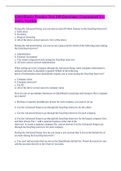Name
Co-Teaching Models and Paraeducator Action Plan
Part 1: Co-Teaching Models
Co-
Teaching
Model:Definition and Visual
of ModelAdvantages and
DisadvantagesInstructional
StrategiesPositive Effects Responsibility
and
Accountability
1. One Teaching, One Observing One teacher has primary
responsibility, and the other conducts detailed observational reports on
teaching pupils or workers. The secret to this approach is to have a visual orientation (Treahy, & Gurnagus, 2010).Teachers in this model require minimal teamwork/cooperation to practice the classes. On a given subject, the stronger instructor (the one who teaches) will disguise the partner's weakness. Not all teaching specialists, however, will make full use
of the paradigm (Drescher, 2014).To test how well they follow directions and the other lessons, one
teacher tests learners.Require uninterrupted delivery instructions for teachers. The data are input correctly during the observation General education
teacher: Lead the lesson.
Teacher, special education for paraprofessionals: tracks, records data and regulates conduct.
2. One Teaching, One Assisting In this style of training, one teacher serves as a lead mentor and the other helps with instructional duties, delivering individual student instruction, and coordinating social community activities (Johnson, & Brumback This model fosters collaboration between teachers in general and special educations in the same classroom. Teachers can reflect and share perspectives in the classroom and students can
receive more feedback and encouragement through While most advice is performed by the lead
teacher, the support teacher can wander the room and assist any student seeking additional assistance.Enable orders from teachers to deliver without interruption.General education teacher: Lead the lesson.
Special education instructor, paraprofessional: assisting students with extra instruction, managing This study source was downloaded by 100000846041611 from CourseHero.com on 02-11-2023 01:13:06 GMT -06:00
https://www.coursehero.com/file/72044662/SPD-521-week-2-Assignment-Co-teaching-Modeldocx/ACTION PLAN Name
2013). guided teaching and laboratory activities. But there continues to be a void
in politics. The pupils prefer more to follow only the instructions of the lead teacher (Keene, 2018).behavior, carrying out social community activities, dealing with administrative duties.
3. Station Teaching The pair of co-teachers separate the teaching material into sections, and the students into lessons. At the station, groups expend a specified amount of time. A different station and the two instructor-
driven stations are also in use (Treahy, & Gurnagus, 2010).In this model, depending on their skill, each teacher may practice an area or lesson separately. The pupils are all faced with the
same content, but they can be broken into separate levels to allow them to understand further beyond their ability (Drescher, 2014).Station has the challenge to solve for
students, and the tasks must be straight
forward. Moreover, the students must specifically mention the relevant principles.The teachers can minimize the setup time by using station
teaching approaches and plan the learning
materials. It also provides opportunities for a diverse group of students to take some responsibility for their academic environmentBoth teachers: schedule classes, prepare materials, and build stations.
Paraprofessional: support teachers in
planning when appropriate, and support in supervising/manag
ing the classroom.
4. Parallel Teaching Teachers are working together to teach each teacher half the classroom (Treahy, & Gurnagus, 2010).By splitting the class into smaller classes, the teachers will provide the students with more individual focus as well as stronger emotional management. This model, however, also demands each teacher to be equally strong in their field of instruction, pacing well, and communicating well (Keene, 2018).All teachers have a question-and-answer discussion on themes and have a good chance to discuss the curriculum for marginalized students.Acting in a smaller group increases appreciation for both
student and teacher's
ability to control the pupils and study the subjects.Both teachers: plan
for the lectures, lead the groups.
Paraprofessional: Classroom/materia
ls help teachers set
up. Supervises and
monitors instructor
behavior.
Alternative methods of This paradigm provides One teacher leads a In the same school, All teachers plan This study source was downloaded by 100000846041611 from CourseHero.com on 02-11-2023 01:13:06 GMT -06:00
https://www.coursehero.com/file/72044662/SPD-521-week-2-Assignment-Co-teaching-Modeldocx/





